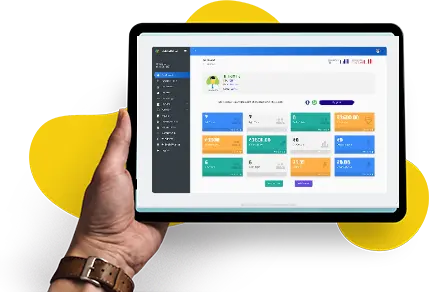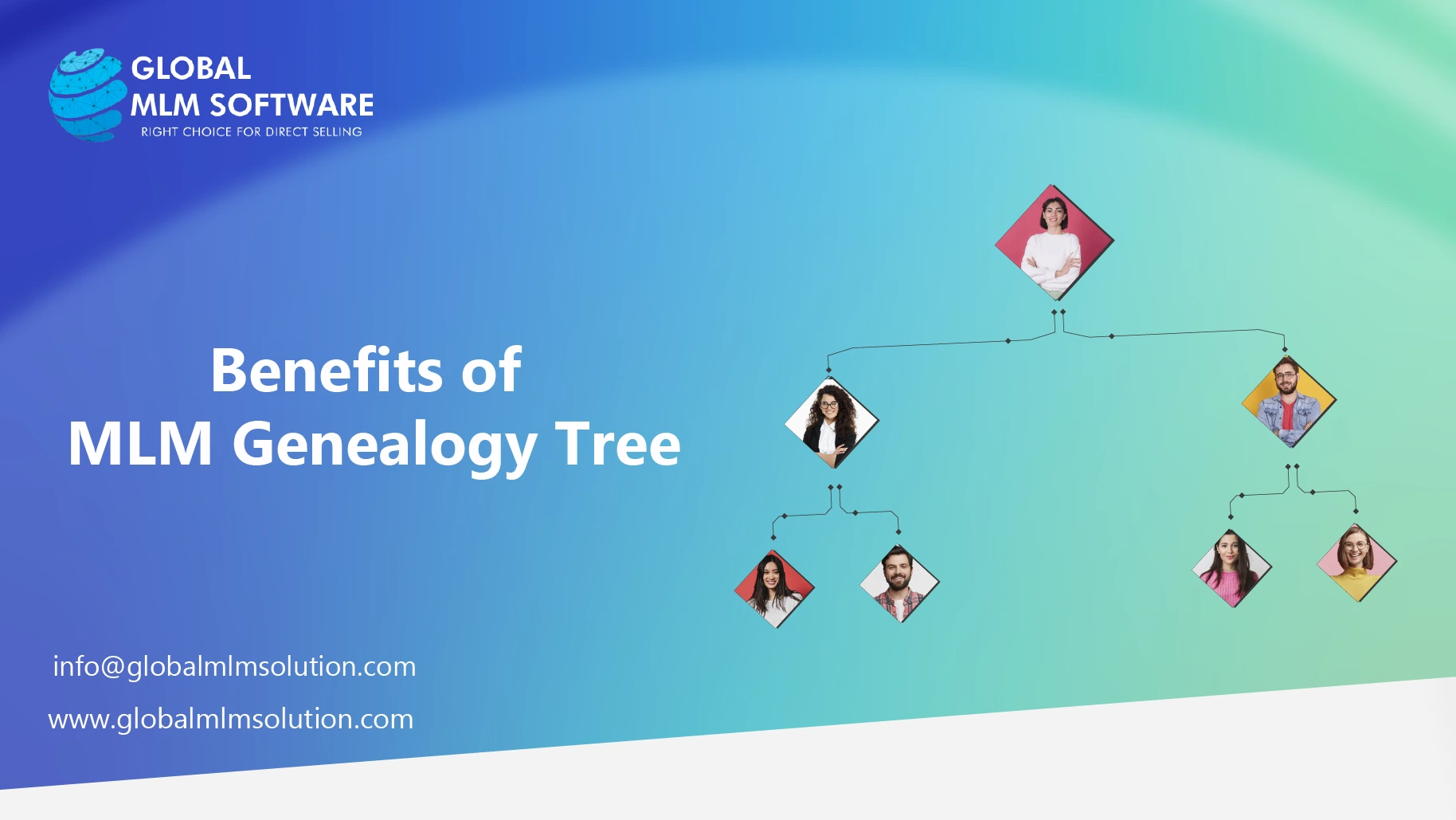In multi-level marketing, distributors are recruited and placed in a structured system. Under this framework, there are two key roles for every distributor: to recruit an individual and become an upline, or get recruited by someone and become a downline.
Whether you're considering a matrix, unilevel, or binary plan, the upline and downline function differently. Only when you understand these differences can you make an informed decision. Further, the creation of compensation plans, ranks, awards, and bonus structures depends on them. Additionally, understanding both roles is critical because it brings clarity on how your brand will scale.
We would like to request that you consider yourself a distributor and read the blog from that perspective. This will help you understand the concepts much better.
This Article Contains:
What is a Upline in Network Marketing?
As per the FTC, a participant’s “upline" refers to the individual who initially recruited them, along with the person who recruited that recruiter, and so on. In simple terms, an upline includes the direct sponsor and everyone above them in the chain.
Let’s take an analogy to make it clearer:
Suppose we have the following structure:
A recruited B
B recruited C
C recruited D
D recruited E
In this case:
E is the newest recruit, recruited by D.
D is E’s direct upline (who directly introduces to the business).
Plus, A, B, and C are also E’s upline because they are positioned above D in the same chain of recruitment.
What Is a Downline in Network Marketing?
When an individual who is already a distributor in an MLM company sponsors or recruits someone under them, that person is known as the downline. As the distributor continues recruiting more people, the size of the downline increases increasing.
Let’s break this down:
Suppose John joins an MLM company and introduces four people: Tom, Arnold, Mitchel, and Jimmy. These four people are John’s direct downline; John personally enrolled them. However, the downline expands beyond just personally enrolled people. Even the people recruited by Tom, Arnold, Mitchel, and Jimmy will become part of John’s downline.
Here’s how it works. Let’s say:
Tom brings in Chris and Diana.
Arnold recruits Ethan, Fatima, and Grace.
Mitchel introduces Henry and Isla.
Jimmy brings in Jason and Kate.
Even though John didn’t personally enroll them all, they are all part of his downline because they joined through the people he recruited.
And it doesn’t stop there. If these recruits recruit members under them, they’ll also be considered as John's downline.
Therefore, a downline can be one person or resemble a big tree, known as a genealogy tree, with branches extending downlines at all levels.
This downline will keep on growing in two ways:
Width: Distributors recruit more people themselves (e.g., John adds new direct recruits beyond Tom, Arnold, Mitchel, Jimmy).
Depth: The people in the team (like Tom and Arnold) build their own teams by recruiting others.
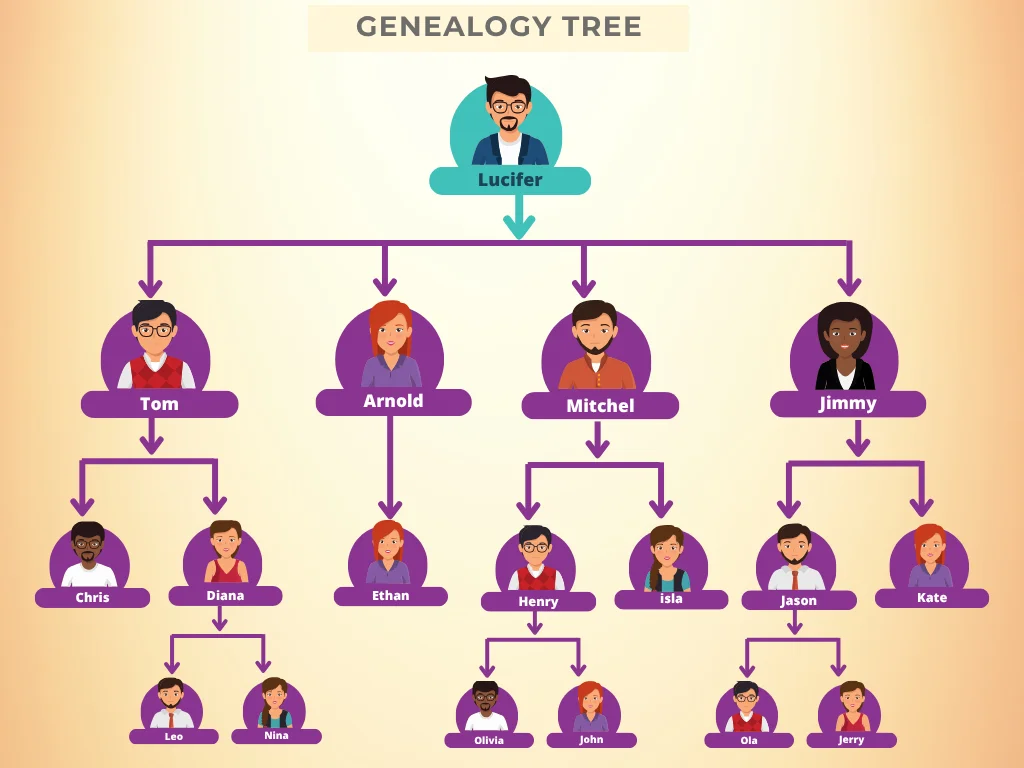
Upline and Downline Structure in Different Types of MLM Plans
In MLM, how the team grows and how commissions are earned depend largely on the structure of the compensation plan. The three most common MLM structures are: Binary, Unilevel, and Matrix. Each one handles uplines and downlines differently.
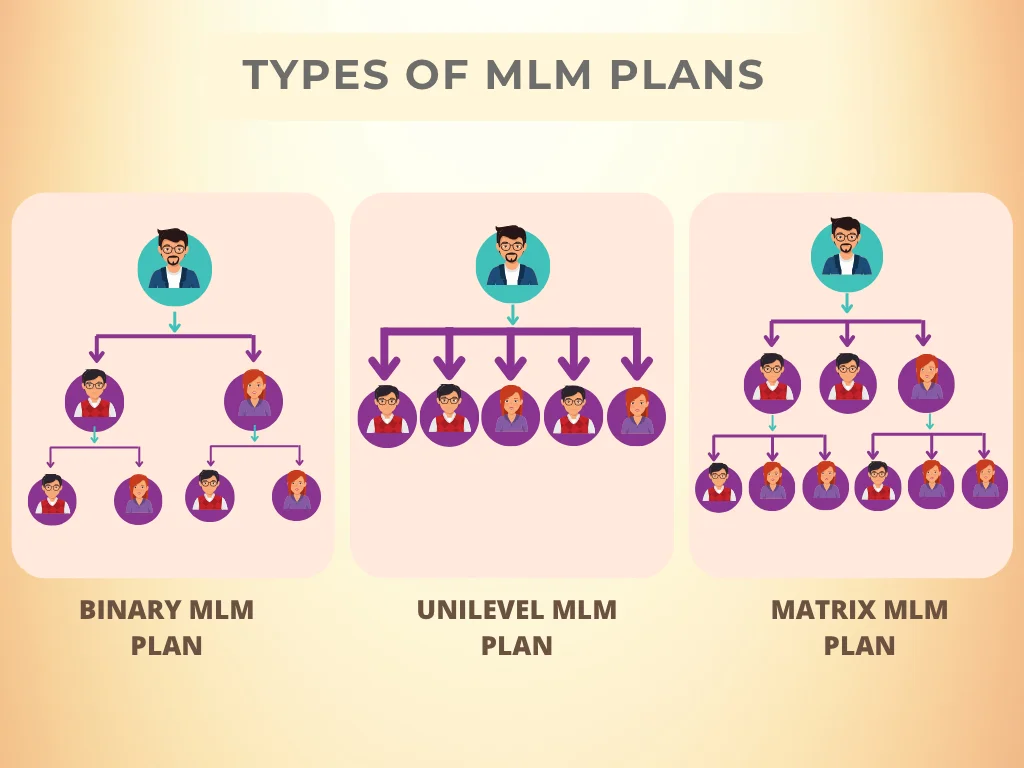
1. Binary MLM Plan
In a binary MLM (multi-level marketing) compensation plan, each upline can sponsor only two people as their direct downline. Therefore, only two “legs” are formed, usually referred to as the left leg and right leg.
But it doesn’t stop there. If an upline (let’s say John) brings in more than two people into his downline, say he recruits Tom, Arnold, Mitchel, and Jimmy, then only two can become his direct downline. The rest must be placed under his existing downline. This overflow is called a spillover.
Example:
John (everyone's upline) recruits four people and creates a binary downline where:
Tom is placed on his left leg.
Arnold is placed on his right leg.
Mitchel (3rd recruit) gets placed under Tom’s leg.
Jimmy (4th recruit) is placed under Arnold’s leg.
So Tom and Arnold now have a team member each, not because they recruited them, but because their upline (John) did.
Plus, if Tom or Arnold plans to recruit their one person each in their respective downlines, they can place them alongside Mitchel or Jimmy, completing the limit of two frontlines. This structure continues to grow deeper, creating a series of uplines and downlines.
2. Unilevel MLM Plan
In a unilevel MLM plan, each upline can directly sponsor as many people as they want. There’s no limit on how wide the downline can go. That means if John is an upline, he can build a frontline of five, ten, or even twenty direct recruits, all placed in his first level.
Unlike binary plans, there’s no left leg or right leg to manage. Everyone whom John personally enrolls becomes his first-level downline. And when his downline members bring in their own recruits, those become John’s second-level downline, and so on.
Example:
Let’s say John is the upline, and he recruits:
Tom
Arnold
Mitchel
Jimmy
Sarah
All five are directly placed in John’s first level. Now:
If Tom brings in Chris and Diana, they become Tom’s direct downline and John’s second-level downline.
If Diana later recruits Brian, Brian becomes Diana’s first-level downline, Tom’s second-level downline, and John’s third-level downline.
The structure continues to expand downward as more people join. This creates a deep chain of uplines and downlines.
3. Matrix MLM Plan
The width and depth of downlines are preset and limited in the Matrix MLM plan. That means there's a fixed number of people anyone can have on their first level and a fixed number of levels they can earn from. This structure generally looks like a 3x3, 4x7, or 5x10 matrix, depending on what kind of compensation design you prefer.
Let’s take a 3x3 matrix as an example.
John joins an MLM company with a 3x3 matrix plan and starts building his team:
He recruits Tom, Arnold, and Mitchel (that’s his maximum for level 1)
Tom recruits Chris, Diana, and Brian (John’s level 2)
Chris brings in Emily, Josh, and Natalie (John’s level 3)
Now, if John wants to recruit a fourth person, let’s say Jimmy, he can’t place Jimmy in his first level because it’s full. So, where does Jimmy go?
Jimmy has to be placed in the next available spot in the matrix, which could be under Arnold, Mitchel, or even deeper, depending on availability. This creates spillover, similar to binary, but within a fixed grid.
Here’s how upline/downline relations work in this setup:
John can become the upline of a maximum of 27 people in his 3x3 matrix, whether he recruited them directly or not.
Tom is the upline of Chris, Diana, and Brian, but also a downline of John.
Chris is a downline to Tom and John, and an upline to Emily, Josh, and Natalie.
So the relationship layers are clear: an individual is always someone’s upline and someone else’s downline, depending on where they are in the matrix.
How the Upline and Downline Relationship Works?
There is a deep relationship between an upline and a downline. It can be referred to as two sides of the same system that overlap with each other. That means, one person’s upline is often another person’s downline.
How is that possible? Let’s understand with an example.
Suppose John joins an MLM company and brings in Tom. In this case, John is the upline and Tom is his downline.
Now, Tom goes on to recruit Chris and Diana. For them, Tom becomes the upline, and they are his downline. But at the same time, Tom is still John’s downline.
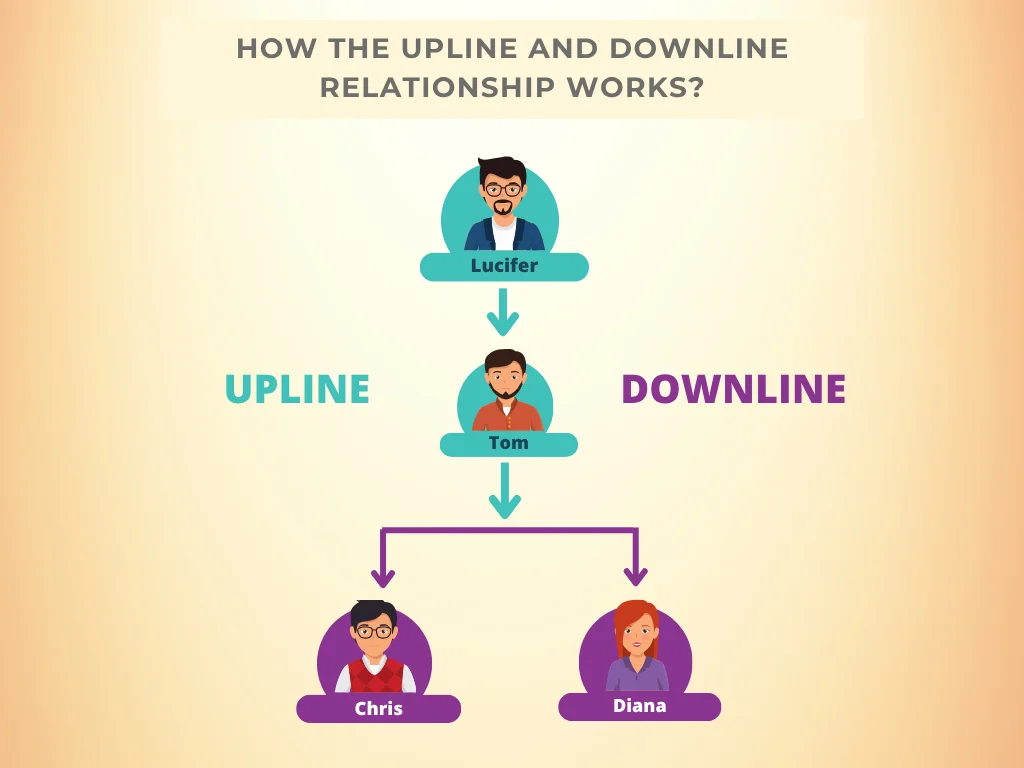
So the same person can be an upline to some and a downline to others, depending on where they sit in the hierarchy. This chain continues as the team grows both in width (more direct recruits) and depth (recruits of recruits).
Additionally, to help you understand the core functional differences between uplines and downlines, here’s a simple comparison:
| Feature | Upline | Downline |
|---|---|---|
| Position in Hierarchy | Is in a leadership position. | Below the leader. |
| Recruitment Role | Recruits downline. | Recruited personally by upline. |
| Main Function | As a leader, they mostly provide mentorship, training, and support. Most uplines pause direct recruitment once their downline becomes larger. | Product sales and new recruitment to create their own teams. |
| Income Opportunity | Earns from his own sales and earns commission from the entire direct and indirect downline. | Earns from his own sales and the people he recruits, but doesn’t get any commission from the upline’s sales. |
Responsibilities of an Upline vs Downline
There are different responsibilities of both downlines and uplines that help the company they are associated with grow.
Upline Responsibilities
The primary responsibilities of an upline include:
Recruiting and onboarding new members.
Providing initial and ongoing training so downlines understand the products, systems, and compensation plans.
An upline also provides resources such as customized marketing materials and strategies to their downline.
Motivating downlines by hosting regular meetings, answering their questions, and helping them solve any issues they are facing.
Downline Responsibilities
The primary role of the downline includes learning, applying, and duplicating the marketing systems designed by their upline. However, the primary responsibilities also include:
Actively promote products/services and bring in more business so the team’s business goals can be achieved.
Support their uplines by following the rules, systems, strategies, and product guidelines.
Helping their upline in organizing seminars, meetings, or team events so they can mentor effectively.
Recruit and support their own downline when they are ready, and expand the downline depth of their upline.
Take responsibility for personal and team sales targets.
Why Understanding Upline and Downline Structure Is Crucial Before Building an MLM?
Before starting your MLM business, knowing how the upline-downline structure brings you clarity to create a truly rewarding opportunity. Here’s why apprehending both concepts is crucial:
Helps Design A Balanced Compensation Plan: The structure you choose directly affects how commissions are paid. For instance, in a binary plan, the downline spreads across two legs, while in a unilevel plan, it can grow horizontally and vertically without limit. If you don’t understand how these layers interact, your payout model could either be unsustainable or unattractive to distributors.
Defines Team Dynamics: An upline isn’t just a recruiter; they act as a trainer, strategist, and support system. Similarly, a downline isn't just a list of names; they're your MLM company’s salesforce. Knowing their interdependence and correlation helps you create leadership roles, recognition programs, bonuses, and training systems that support growth.
Supports Long-Term MLM Growth: Many businesses fail because their structure leads to burnout, commission overload, or leadership gaps. A clearly mapped upline-downline system helps maintain balance, ensures mentorship, keeps distributors motivated, and creates a strong base for replication and scale.
Common Misconceptions About Upline and Downline in MLM
People usually make inaccurate assumptions when they hear the terms upline and downline for the first time. Let's dispel some of the most widespread misconceptions:
The Upline Just Makes Money Without Doing Anything
This idea couldn’t be further from the truth in a healthy MLM structure. A good upline isn’t like a recruiter who gets commission just for recruiting. Instead, most uplines play the roles of mentor, strategist, marketing expert, and support system for their downline.
They invest time in training their team, solving problems, and helping others grow. Without an engaged upline, most downlines stall or drop out entirely. They earn commissions from a team, but only when the upline actively helps that team succeed.
Downlines Are Just Lower-Level Participants
Being part of a downline doesn’t mean a person is stuck in a secondary role. In fact, many of the top income earners in MLM started out just like everyone else, in someone else’s downline. What sets them apart is how effectively they built and supported their teams. A downline has the same potential for success as an upline; the difference is in the action taken.
Only Earn from People Who Are Directly Recruited
This is one of the most common misunderstandings. In most MLM plans, your income comes not just from your direct recruits but from your entire network, often several levels deep. That means the people your recruits bring in (and their recruits) all become part of your downline, helping generate passive income as your network expands.
Must Constantly Recruit to Earn
While recruitment is one way to grow, real, lasting income in MLMs comes from product sales of an upline and its downline. Many successful distributors focus just as much on helping their teams sell effectively as they do in bringing in new members. The business thrives when people use and love the product, not just when more people join.
Most distributors begin by focusing on their personal product sales to gain experience, understand the system, and build strong customer relations. Once they become confident sellers, they often expand their impact by recruiting and mentoring others, eventually becoming uplines. However, their focus still remains on helping others sell products and not on teaching how to recruit others.
Conclusion
The entire multi-level structure is built on a network of uplines and downlines. Although it may seem complex and technical, it is actually quite simple, resembling the way tree branches grow or how a family tree is organized.
Before you create a compensation plan, just focus on what kind of upline-downline structure you’d like in your business. This clarity at an early stage will help you avoid mistakes that can cause issues in scaling the brand.
FAQs
1. What is the difference between downline and upline in MLM?
The primary difference between downline and upline is in their placement within a compensation plan. An upline is placed in the leadership role, whereas a downline is recruited by the upline and placed in their legs.
2. Who is my direct upline?
Your direct upline is the individual who introduced or sponsored you to an MLM company.
3. What is an example of an upline?
A real-world example of an upline is Steve & Gina Merritt, distributors in the LifeWave MLM company. They are the upline of a large team that spans over 71,000 people with direct and indirect downlines.
Disclaimer: Global MLM Software does not endorse any companies or products mentioned in this article. The content is derived from publicly available resources and does not favor any specific organizations, individuals or products.




